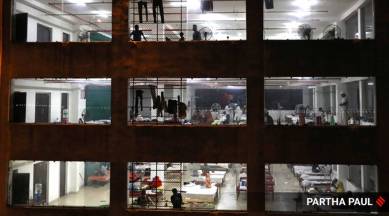Kaunain Sheriff M is an award-winning investigative journalist and the National Health Editor at The Indian Express. He is the author of Johnson & Johnson Files: The Indian Secrets of a Global Giant, an investigation into one of the world’s most powerful pharmaceutical companies. With over a decade of experience, Kaunain brings deep expertise in three areas of investigative journalism: law, health, and data. He currently leads The Indian Express newsroom’s in-depth coverage of health. His work has earned some of the most prestigious honours in journalism, including the Ramnath Goenka Award for Excellence in Journalism, the Society of Publishers in Asia (SOPA) Award, and the Mumbai Press Club’s Red Ink Award. Kaunain has also collaborated on major global investigations. He was part of the Implant Files project with the International Consortium of Investigative Journalists (ICIJ), which exposed malpractices in the medical device industry across the world. He also contributed to an international investigation that uncovered how a Chinese big-data firm was monitoring thousands of prominent Indian individuals and institutions in real time. Over the years, he has reported on several high-profile criminal trials, including the Hashimpura massacre, the 2G spectrum scam, and the coal block allocation case. Within The Indian Express, he has been honoured three times with the Indian Express Excellence Award for his investigations—on the anti-Sikh riots, the Vyapam exam scam, and the abuse of the National Security Act in Uttar Pradesh. ... Read More
Tamil Nadu outlier but on an average, 69% of COVID-19 cases in each state from just 3 districts
Nationally, when it comes to recovered patients, more than half (55.55 per cent) come from these three districts in a state; also, an average 63.9 per cent of deaths, too, are from here.

MORE than three weeks into the national lockdown, an average of 69 per cent — almost seven of 10 — of all active Covid cases in a state are concentrated in just three of its districts, an analysis shows.
This trend holds pointers to not only working out the easing of the lockdown post-April 20, it is key to designing public health interventions to contain the outbreak.
monthly limit of free stories.
with an Express account.
This case load pattern reflects in recovery and death as well.
Nationally, when it comes to recovered patients, more than half (55.55 per cent) come from these three districts in a state; also, an average 63.9 per cent of deaths, too, are from here.
Read | Coronavirus cases have slowed under lockdown, says Govt; 3 strains found
This statewise concentration in three districts is significant as the government identified 170 districts in 25 states as hotspots.
As member of the high-level technical committee and AIIMS Director Randeep Guleria had told The Indian Express, one goal of any containment strategy, in a lockdown, is to localise higher number of cases to one area rather than having pockets scattered all around. This enables better use of limited health resources and their ramping up, if needed.
This three-district zone also helps states decide where to ramp up testing and household syndromic surveillance — detecting early signs of any outbreak. Or how and where to ease restrictions or adopt more aggressive containment strategies.
Also Read | Different world post-COVID… Work from home may become new norm, says Ravi Shankar Prasad
Significantly, in the three states of Maharashtra, Madhya Pradesh and Gujarat, which border each other and account for over 4,200 active cases, three districts in each state account for 80 per cent of the cases.
In Maharashtra, 89.27 per cent of the cases are concentrated in Mumbai, Pune, and Thane, and 83 per cent of recovered patients are from these three district; in Gujarat, 84.87 per cent of cases are concentrated in Ahmedabad, Vadodara and Surat, and 52.05% of the recovered patients are from these three districts; in Madhya Pradesh, 81.51 per cent of the total cases are concentrated in Indore, Bhopal and Khargaon.
Similar is the trend in the south.
In Andhra Pradesh, the districts of Guntur, Kurnool and Nellore; Hyderabad, Nizamabad and Vikarabad districts in Telangana; in Karnataka, the districts of Bangalore, Mysuru, and Belagavi and in Kerala, the districts of Kasargod, Kannur and Ernakulam — an average 63 per cent of the cases are concentrated in three districts in these states.
Explained | How coronavirus attacks, step by step
And an average 50% percent of the recovered patients are from these three districts.
In Uttar Pradesh, there is a slight dip in percentage: the top three districts Agra, Lucknow and Gautam Buddha Nagar account for 45 per cent of total active cases – one reason is the large geographic sprawl of the state.
However, in Bihar, Haryana, Punjab and Rajasthan, three districts contribute to an average 60 per cent of total active cases.
One state which is the outlier is Tamil Nadu where cases are spread across. Data shows that the top three districts account for only 33.46 percent of active cases: Chennai (217), Coimbatore (127), and industrial hub Tirupur (80).
Two districts have cases in the range of 79-80; three districts have cases in the range of 65-50 ; and as many as eight districts have cases in the range 40-35.
Of the 1267 cases in the state until April 16, the death toll stands at 15.
Tirupur is also responsible for 90 per cent of the total cotton knitwear exports from India.
Don’t miss these articles on Coronavirus from the Explained section:
‣ How coronavirus attacks, step by step
‣ Mask or no mask? Why the guidance has been shifting
‣ Besides a face cover, should I wear gloves when I go outdoors?
‣ How the Agra, Bhilwara and Pathanamthitta Covid-19 containment models differ